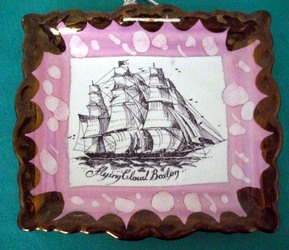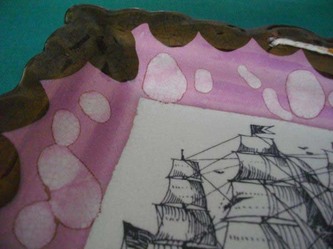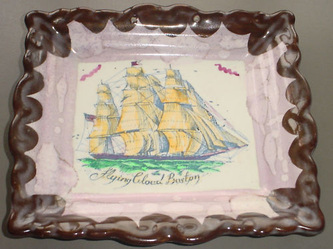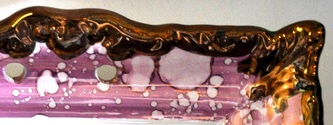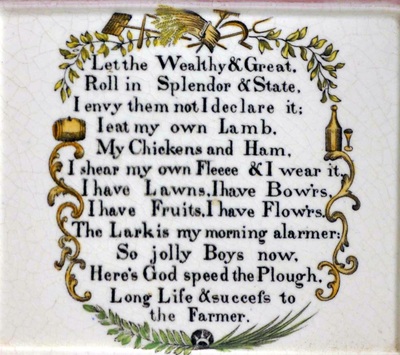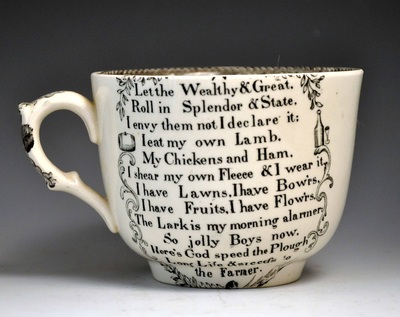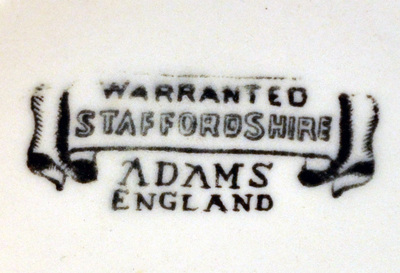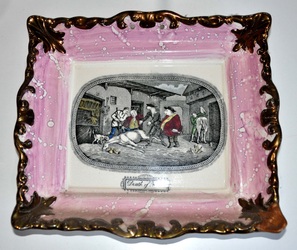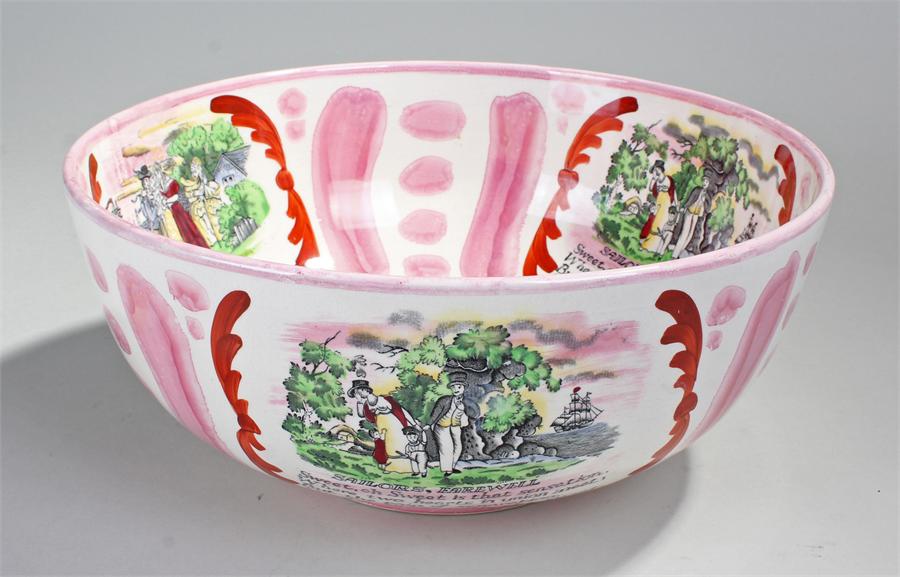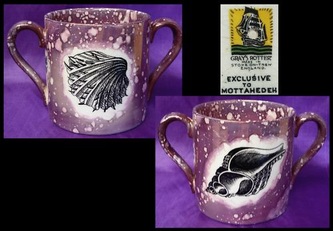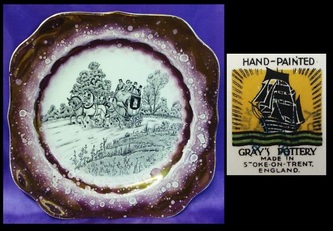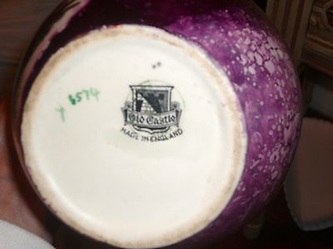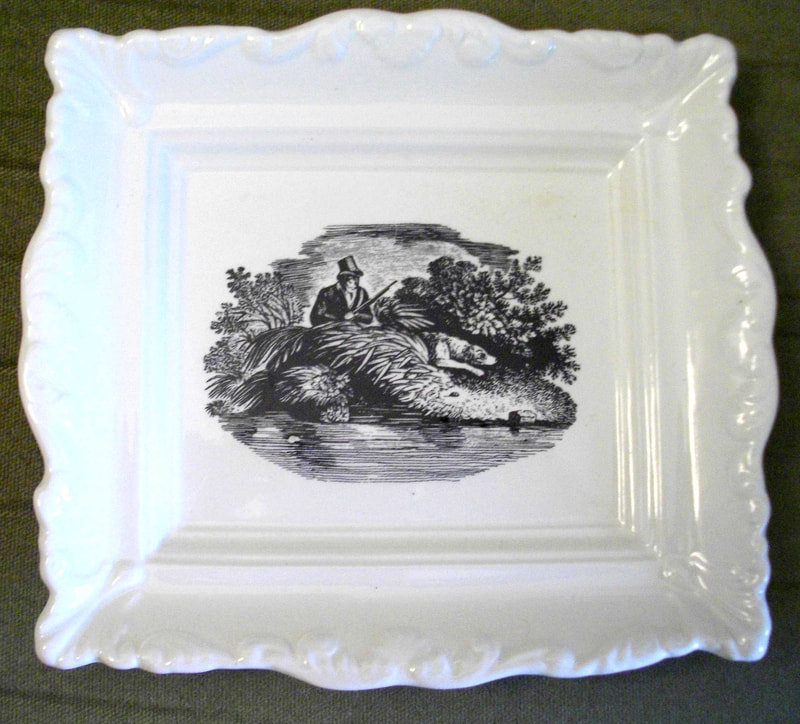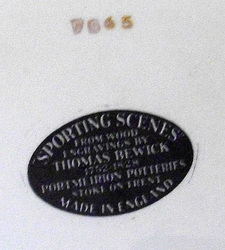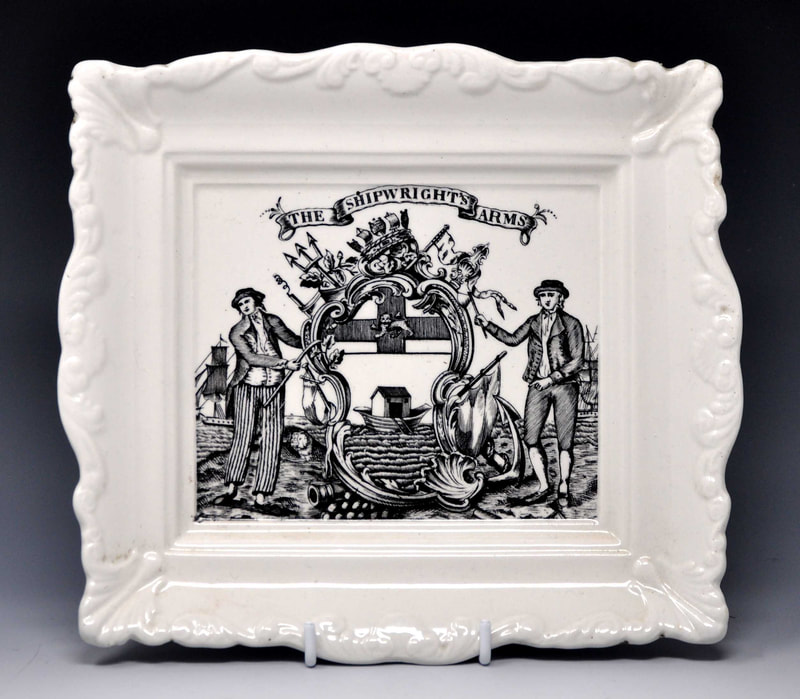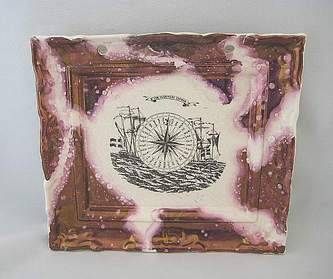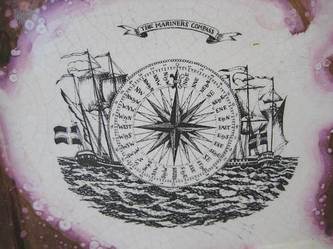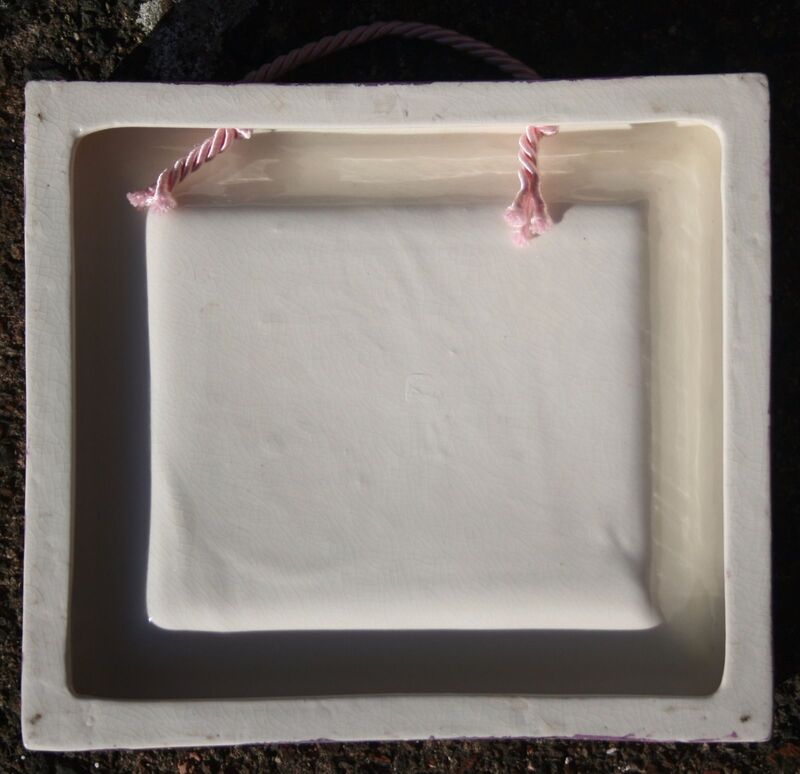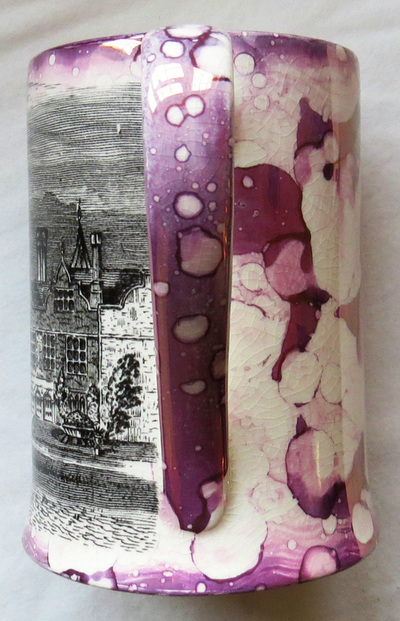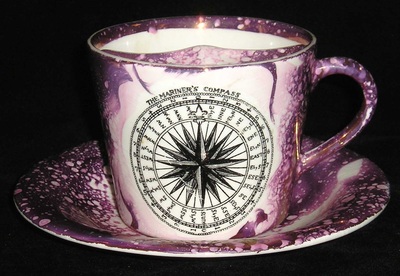Reproductions
Flying Cloud Boston and Agamemnon
With the permission of the author, Ian Holmes, I'm including this article on reproductions. It was originally produced as an eBay guide, but is supplemented here with photos.
'Sunderland lustre' has become the accepted name for all pottery decorated with pink lustre irrespective of its place of manufacture. During manufacture the applied gold leaf changed to pink. The pink areas should always give a golden lustre, especially on the edges of the pink or where it has been sponged. Many items listed on ebay as 'Sunderland' were not actually made in Sunderland or even in the North-East of England. They do however normally date from 1820 to 1870 and are valid antiques.
Two plaques which have regularly appeared on ebay feature ships called 'FLYING CLOUD BOSTON' and 'AGAMEMNON'. These were made in about 1980 as Sunderland Lustre reproductions. They sold for a few pounds and were good as decorative items. However inevitably they have been passed on as genuine antique, the 'too good to be true' price being tempting.
Two plaques which have regularly appeared on ebay feature ships called 'FLYING CLOUD BOSTON' and 'AGAMEMNON'. These were made in about 1980 as Sunderland Lustre reproductions. They sold for a few pounds and were good as decorative items. However inevitably they have been passed on as genuine antique, the 'too good to be true' price being tempting.
How do we know these are fake?
1 The pink is dull and lacks the lustre effect (see photos below).
2 'FLYING CLOUD BOSTON' was never used by Sunderland potteries (the name does appear on items by other potteries but very unlike the repro).
3 'Agamemnon in a Storm' is a genuine 19th century transfer showing an almost capsized ship, BUT simply AGAMEMNON was never used and the ship shown is not in distress (see footnotes below).
4 The plaques are undersized and lack well-defined moulded borders.
5 The crazing is too perfect.
6 You will probably never see a damaged or restored AGAMEMNON or FLYING CLOUD BOSTON plaque (because they are so new and also if broken not worth restoring).
7. They often appear together as a pair - in shops or on ebay usually with no other genuine Sunderland lustre items
1 The pink is dull and lacks the lustre effect (see photos below).
2 'FLYING CLOUD BOSTON' was never used by Sunderland potteries (the name does appear on items by other potteries but very unlike the repro).
3 'Agamemnon in a Storm' is a genuine 19th century transfer showing an almost capsized ship, BUT simply AGAMEMNON was never used and the ship shown is not in distress (see footnotes below).
4 The plaques are undersized and lack well-defined moulded borders.
5 The crazing is too perfect.
6 You will probably never see a damaged or restored AGAMEMNON or FLYING CLOUD BOSTON plaque (because they are so new and also if broken not worth restoring).
7. They often appear together as a pair - in shops or on ebay usually with no other genuine Sunderland lustre items
A genuine transfer titled 'Agamemnon 91 Guns' is known to exist on jugs (see below left), but it is very different, and to the author's knowledge was never used on plaques. The centre photo shows 'The Agamemnon in a Storm' referred to in the text above. The right picture shows the source for the reproduction transfer, from the Illustrated London News, which actually depicts the Australian clipper ship 'Marco Polo'. 19th century plaques were made using this image (see common ships) but are easily distinguishable from reproductions, because they aren't titled.
The two plaques below are double whammies, being both reproduction and over-painted. See the Over-painted items page for more examples of plaques with faked enamels.
Adams pottery reproductions
In the first half of the 20th century, Adams Pottery in Staffordshire appears to have copied a Garrison Crimean plaque of an English and French sailor shaking hands. Although the plaques are technically reproductions – having been made in the wrong place in the wrong century – they are almost 'antiques' in themselves, and have value to collectors. My best guess is that they were made between 1914–1930.
The first two plaques below are the Adams-attributed copies, which are unmarked. The third plaque (below right) is a Garrison original, with the 'Dixon Co' impress made circa 1855.
The first two plaques below are the Adams-attributed copies, which are unmarked. The third plaque (below right) is a Garrison original, with the 'Dixon Co' impress made circa 1855.
Though the copies are nearly always listed as 19th century originals, they are easy to tell apart. The blue on the original (right detail below) is darker – closer to Prussian blue. The red and green are also different, though that's harder to tell in these photos. The Adams-attributed copies are generally much more neatly painted. Compare their enamels with the broad wash of colour over the flag on the Dixon version (right).
The Adams-attributed plaques have a very distinctive moulded border (below left), which NEVER appears on genuine Sunderland plaques. Compare it with the Garrison version on the right.
Adams produced a whole range of these plaques. Both pink-lustre and copper-lustre edged versions are found for most of the transfers. They are attributed to Adams on the basis of their shared transfers with marked Adams' wares. The transfers of the unmarked plaques below (below left and centre photos) match those on the marked Adams' cup (below right).
The first two details below show the too-neat decoration of the Adams-attributed plaques. N.B. the farmers' arms transfer on the cup has details picked out in yellow in the same way. Below right is the 20th century Adams' mark on the cup above.
Below are two unmarked plaques attributed to Adams. The first is titled 'Death of Punch' and shows a scene from Dr Syntax. The second is a cock fighting scene, 'Set Too', after a print by Henry Alken. Both are shown beside Adams' wares with the same transfers and an Adams' printed marks.
Another of these Adams-attributed reproductions is the train plaque (below left). Similar transfers appear on a variety of 20th century wares. N.B. the other two items shown below are not from Adams Pottery. As far as I know there are no genuine 19th century train plaques. However, the plaques are nearly always falsely listed as Sunderland originals and command high prices.
One reason why these plaques are mistaken for 19th century items is that they are very prone to stress lines and crackle (see below left and centre). Also, the corners protrude forwards and are vulnerable to breakage. Many of these plaques have old repairs to their corners. This gives them an old appearance.
Finally, for the doubters, here is one of these plaques with an Adams' printed mark. It was used at their Greenfield site 1914–1955, and at their Greengates site 1914–1970.
One final point to note. Of the 8 plaques shown above, 6 of them were found in the US. It seems that Adams made these plaques for export to America. That is reflected in the variation of the 'May Peace and Plenty' plaque below. There is no verse referencing the 'British Isle', and the ship carries an American flag.
Fielding's Crown Devon
These early to mid 20th century Staffordshire transfers have an attractive retro feel. I've seen the jugs below listed on eBay as 19th century originals, with a prices to match. Sometimes with the mark scratched off. I haven't been able to find an exact match for the printed mark, but this website shows similar marks in use between c1917 and 1930.
Gray's pottery
These objects from Gray's pottery are usually clearly marked, and have distinctive deep lustre borders (lustre like this never appears on 19th century items). Despite being 20th century, they are good decorative items and collectable in their own right. Thanks to Paul Niblett who informs me that the above pots are chiefly from the 1950s. He says: I have logged thousands of Gray’s patterns over 35 years – unfortunately, the company’s pattern books were lost many years ago. From these recordings, I estimate that Gray’s splashed lustre patterns
incorporating prints were produced from the mid-1940s through to the first years of the new company, Portmeirion, in the early 1960s. This coincides with Gray’s need to produce for export (North America) at a time when the sale of decorated ware for the British home market was forbidden. The wide (27.5mm) Gray’s Clipper backstamp was in use from 1945-50 (with the words ‘Hand-painted’) and from 1948-61 without). The Mottahedeh patterns, such as the Shell design, were created in the 1950s. Click here for Paul's fabulous Gray's website.
incorporating prints were produced from the mid-1940s through to the first years of the new company, Portmeirion, in the early 1960s. This coincides with Gray’s need to produce for export (North America) at a time when the sale of decorated ware for the British home market was forbidden. The wide (27.5mm) Gray’s Clipper backstamp was in use from 1945-50 (with the words ‘Hand-painted’) and from 1948-61 without). The Mottahedeh patterns, such as the Shell design, were created in the 1950s. Click here for Paul's fabulous Gray's website.
20th century Maling
This item has, according to the Maling Collectors' Society, 'a typical Maling castle mark used from the 1920s through to the factory's closure in 1963. Several variations exist, and the words "Estd 1762", "'Newcastle-on-Tyne", or "Made in England" may or may not accompany the castle'. Without the mark, it would be difficult to distinguish the item from a 19th century original.
Thanks to Ian Sharp for the photos of the mug below. Ian sold the cup as a reproduction and writes:
The mug was produced for a London retailer during the 1930s. Many other items within this range were produced including Masonic jugs, plates, bowls and frog mugs. Many of these pieces were unmarked, as requested by the retailer! Many, however, were produced bearing the Maling Castle mark which was used during the period. The transfers were taken from the original 19th century copper plate which was in Maling’s possession.
To the untrained eye, this mug looks to be a typical 19th century piece. However, the lustre application is not typical with that of an earlier piece, the colour is also “wrong”. The handle is shaped and moulded to the body as opposed to being applied seperately. The shape and size of the mug does look typical of an earlier piece.
Thanks to Ian Sharp for the photos of the mug below. Ian sold the cup as a reproduction and writes:
The mug was produced for a London retailer during the 1930s. Many other items within this range were produced including Masonic jugs, plates, bowls and frog mugs. Many of these pieces were unmarked, as requested by the retailer! Many, however, were produced bearing the Maling Castle mark which was used during the period. The transfers were taken from the original 19th century copper plate which was in Maling’s possession.
To the untrained eye, this mug looks to be a typical 19th century piece. However, the lustre application is not typical with that of an earlier piece, the colour is also “wrong”. The handle is shaped and moulded to the body as opposed to being applied seperately. The shape and size of the mug does look typical of an earlier piece.
Old Castle pottery
'Old Castle’ pots with ‘splashed lustre plus print’ designs were made by Gray’s Pottery or, in the early years of its existence, Portmeirion Pottery.. The 'MADE IN ENGLAND' mark, and atypical quality of the lustre, identify the items as 20th century.
Portmeirion pottery
Although these items are never likely to be mistaken for Victorian pottery, they are of interest to collectors. The pottery designer Susan Williams-Ellis set up the Portmeirion Pottery in 1960.
The Bottle plaque and plates below are reworked versions of the original transfers, and reflect the 60s' taste for Victorian revival.
Miscellaneous 20th century repros
A final reflection on reproductions, written April 2022... Many people have contacted me via this website with false concerns about genuine 19th century items. Rest assured, the vast majority of reproduction items are very easy to spot. The dark-speckled lustre on the items above and below, almost never appears on 19th century items. So, in my view, collectors shouldn't be over anxious about buying a dud. Paradoxically, the value of vintage items has risen, just as the value of originals has dropped, so if you love an item and have paid under £100 for it, just enjoy it!
